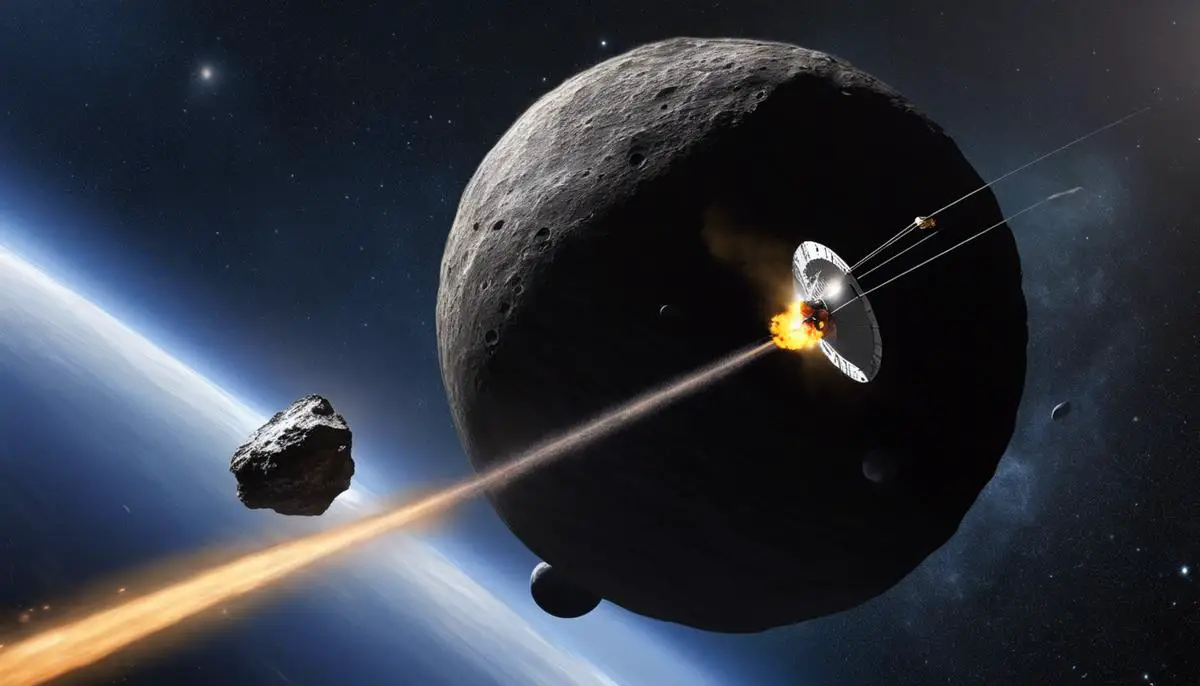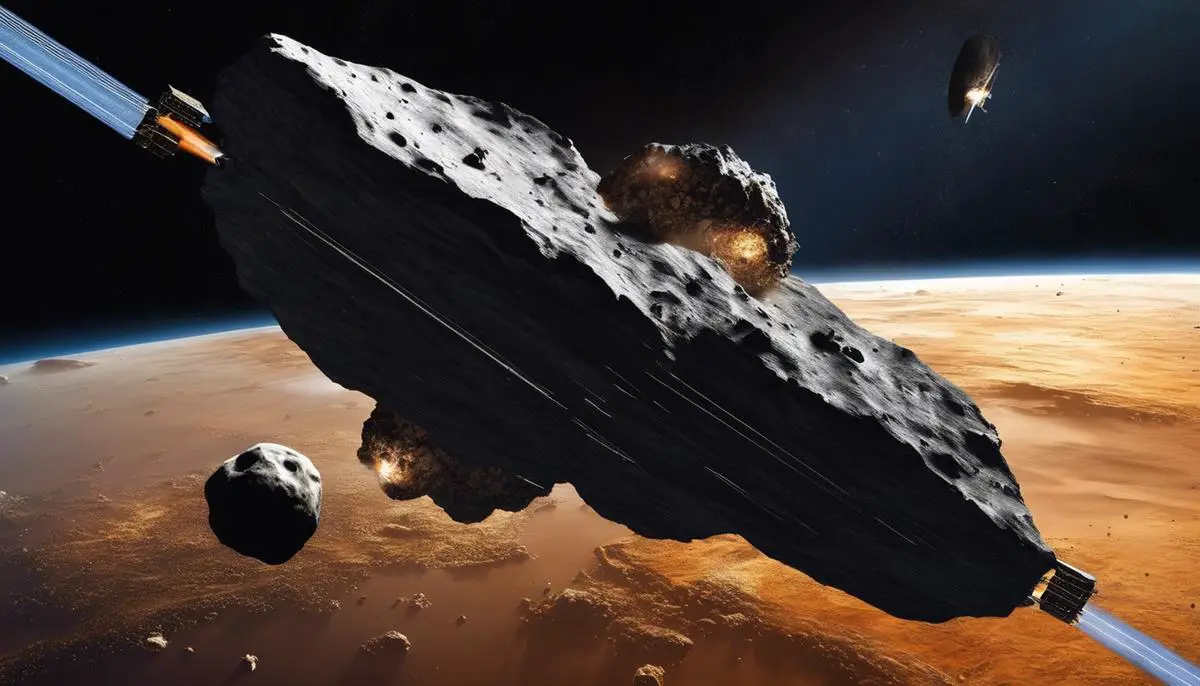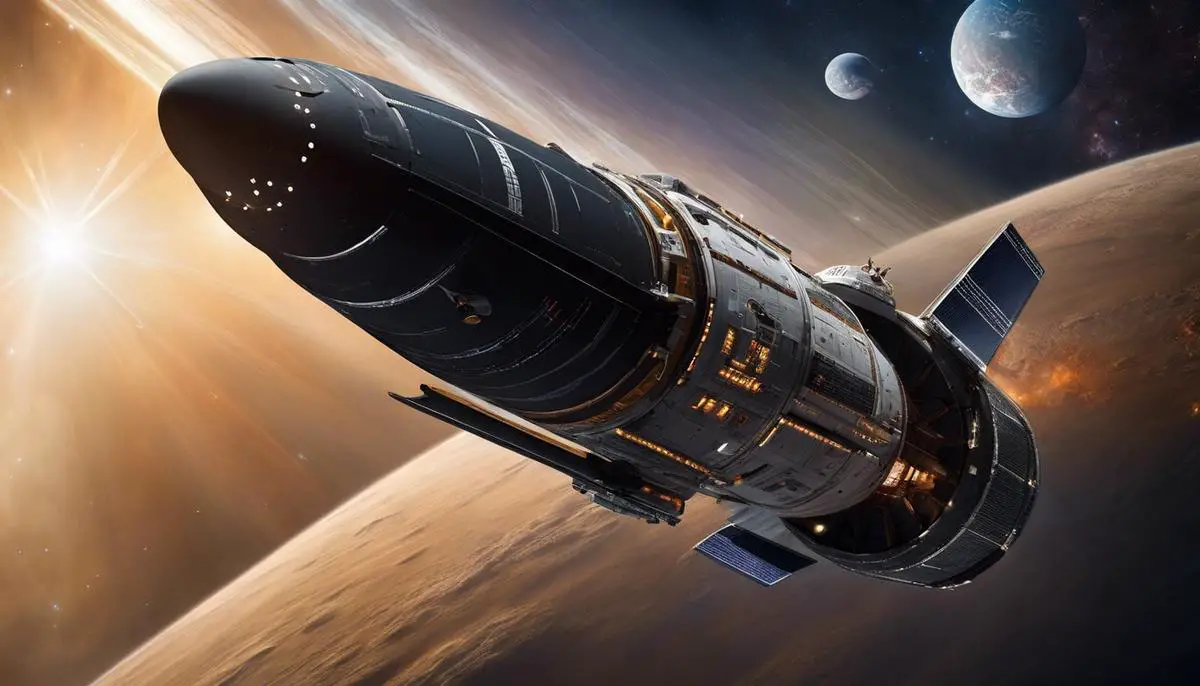Set against the breathtaking backdrop of space exploration, the DART mission stands as a testament to human ingenuity, epitomizing our enduring quest to understand the universe and safeguard our planet. The mission, which aims at altering the trajectory of an asteroid in space utilizing the kinetic impact technique, encapsulates the sophistication and sheer scientific prowess of the organizations and individuals behind it. It highlights the contributions of revered minds such as Dr. Nancy Chabot and Dr. Andrew Rivkin of Johns Hopkins University, exploring the intricate mosaic of their technical acumen and strategic foresight. Moreover, this ambitious undertaking illuminates the power of global unity and shared scientific interest, as seen in the collaborative endeavors between NASA and the European Space Agency.
Understanding DART Mission
The DART Mission: A Leap Towards Planetary Defense and its Scientific Significance
The Double Asteroid Redirection Test (DART) mission, a groundbreaking endeavor spearheaded by NASA, represents the forefront of our efforts in planetary defense. Its objective – to determine our capacity to redirect potentially hazardous asteroids away from Earth – is of unparalleled significance in the realm of celestial dynamics and space exploration.
At the heart of DART lies NASA’s intent to assess kinetic impactor strategy: essentially, the concept of striking an asteroid to alter its course. The target for this mission is an asteroid system known as Didymos, which consists of two celestial bodies: Didymos A, the primary body, and a smaller moonlet named Didymos B, commonly referred to as ‘Didymoon’. The moonlet, roughly 160 meters in diameter, is of foremost interest and constitutes our target for impact.
Initiating in 2021, with impact scheduled for October 2022, DART plans to rendezvous with Didymoon at a speed of approximately 6.6 km/sec. Through this high-speed collision with the minuscule moonlet, scientists aim to change its orbital period by a few minutes, an alteration that, though slight, is sufficient for Earth-based telescopes to observe.
The operation’s primary challenge lies in ensuring precision. The LICIACube (Light Italian Cubesat for Imaging of Asteroids), a shoebox-sized spacecraft, will accompany DART to capture and relay back data regarding the kinetic impact and its aftereffects. This is expected to provide critical quantitative data to validate models predicting the momentum transfer during an asteroid collision.
The DART mission holds the promise to open new horizons in our understanding of asteroids. By providing insights into their physical properties and structures, DART is expected to contribute significantly to our current body of knowledge on their composition and the nature of their surfaces.
On a broader scale, DART’s findings will further our grasp of the celestial dynamics involved when a spacecraft interacts with an asteroid – a valuable piece of knowledge that paves the path for future asteroid mining projects. The DART mission is a monumental step in both the continued pursuit of scientific knowledge and ensuring Earth’s long-term survival in a cosmos filled with potential hazards.
Furthermore, DART is essentially a pioneering venture in the field of active planetary defense, an area that until now, science and technology had only speculated upon. In the context of increasing awareness of our vulnerability to cosmic phenomena, DART represents not just scientific curiosity, but also a commitment to safeguarding our home planet.
In essence, the DART mission is more than just a test—it is a highly-anticipated cornerstone in our collective understanding of planetary security and celestial bodies. With its primed contributions to the future of space travel and asteroid mining—coupled with the immediate need for planetary defense strategies—DART undoubtedlyengrosses the scientific community worldwide.

Scientists and their Contributions
The Double Asteroid Redirection Test (DART) mission, as a multidisciplinary task, has engaged the best minds within the scientific sphere; each brought unique insights and expertise to forge this project to fruition. Their groundbreaking contributions exemplify the blend of scientific rigour, creativity and precise collaboration, creating a chorography optimized for the successful completion of this ambitious project.
At the helm of this venture is Dr. Nancy Chabot, the project scientist for the DART Mission. An expert in planetary science at the Johns Hopkins University’s Applied Physics Laboratory, she effectively coordinates scientific activities, ensures the alignment of mission objectives, and leverages her extensive understanding of asteroids in managing the DART mission.
Dr. Andy Rivkin serves as the Investigation Team Lead and is instrumental in the mission’s development. An acclaimed astronomer, his fortitude underpins the conceptualisation of applying kinetic impact to alter an asteroid’s orbit; positing DART not only as a plausible mission but an as empirical one.
Over at the European Space Agency (ESA), Dr. Michael Küppers provides essential contributions as the Project Scientist for the Hera mission, the critical follow-up to DART. His expertise in cometary science aids in a nuanced understanding of the outcomes post-DART impact, bridging the knowledge gap of deflection results, and reconstructing Didymos’s appearance pre-collision.
In tandem, Dr. Angela Stickle, the DART Impact Modelling Lead, meticulously models collision outcomes at the Applied Physics Laboratory. Dr. Stickle utilizes cutting-edge technology to predict Didymoon’s post-collision orbit, shape, and mass redistribution – a testament to her unrivaled prowess in impact physics and modeling.
Dr. Patrick Michel, Director of Research at the French National Center for Scientific Research, distinctly contributes as the Hera Mission’s Interdisciplinary Scientist. Dr. Michel’s irreplaceable expertise lies in asteroid dynamics and evolution, capable of decoding reams of data post-collision.
Lastly, Prof. Elena Adams, the DART Mission Systems Engineer, designs and manages the critical DART spacecraft systems. Her work keeps DART on a tightly-knit schedule and resource allocation plan, each optimized to maximize the possibility of a successful mission.
The DART mission, a sublime mosaic of distinct scientific fields, carves a new path towards our shared goal of preserving Earth, fueled by minds whose vanguard contributions, deep knowledge and incessantly burning curiosity lay the foundation of an innovative, ambitious and promising future for planetary defense.

Collaborative Endeavours in DART
The Double Asteroid Redirection Test (DART)
The Double Asteroid Redirection Test (DART) is an exemplary manifestation of collaborative brilliance in the field of space science. A constellation of universities, principal investigators, agencies, and countries have tirelessly pooled their genius to usher this ambitious mission closer to reality, shedding new light on how international cooperation is advancing the frontiers of asteroid deflection techniques.
The DART mission is an integral part of the AIDA – Asteroid Impact and Deflection Assessment – project, which is an international effort to study the results of the DART kinetic impact on the moonlet Didymoon. AIDA is a joint venture between two key missions: NASA’s DART and the European Space Agency’s (ESA’s) Hera that will follow close on DART’s heels. While DART, in a first-of-its-kind mission, aims to knock the asteroid off its path, Hera will meticulously survey the resulting impact crater and study the changes in the asteroid’s orbital trajectory.
Understanding that collaboration transcends geographic borders is essential to appreciate the global effort propelling the DART mission. Besides NASA and ESA, other significant contributors include the Johns Hopkins University Applied Physics Laboratory (APL), responsible for the design, building, and management of the DART spacecraft, and the Italian Space Agency (ASI). Both entities underline the crucial role of academia and international space agencies in the successful execution of such a complex venture.
Furthermore, the expertise of a diverse array of scientists is ushering DART into the annals of scientific history. At the helm of affairs are individuals of extraordinary caliber, including the sterling leadership of Dr. Tom Statler, Program Scientist for DART at NASA; Dr. Nancy Chabot, who serves the critical position of Project Scientist; and Dr. Andy Rivkin, the Investigation Team Lead, among others. Equally notable, Dr. Michael Küppers acts as the Project Scientist for the Hera mission,
Individuals like Dr. Angela Stickle, the DART Impact Modelling Lead, and Prof. Elena Adams, the DART Mission Systems Engineer, contribute substantial specialist knowledge to the mission. They are complemented by Dr. Patrick Michel, Hera’s Interdisciplinary Scientist, and educators, engineers, and analysts from numerous national and global institutions. The wealth of experience that these stakeholders bring to the table highlights the importance of diverse intellectual input in achieving DART’s objectives.
Preserving Earth from the impact of potentially hazardous asteroids is a responsibility that demands shared accountability and expertise. Remarkably, these global coalitions are not just technologically and academically symbiotic, but culturally too. This rich tapestry of collective scientific wisdom underscores the pivotal role of international camaraderie and operative harmony in safeguarding our planet.
In this unprecedented venture to protect Earth from asteroid impacts, international collaborations have emerged as the linchpin of success. The DART mission is more than a summation of advanced technology and complex physics. It is a testament to the power of global scientific cooperation in advancing human knowledge and protecting our shared home. By blending thorough research, meticulous planning, and innovative strategies, the DART, and indeed the larger AIDA mission, promises to illuminate our understanding of celestial mechanics, forever reshaping the frontier of planetary defense.

Challenges and Solutions
Moving forward in this immense project, scientists faced numerous challenges. Each came with its own unique set of technical and logistical aspects, but also added a great level of scientific complexity to an already demanding mission. However, each hurdle only increased the collective determination among the project’s team members to make the mission a success.
An initial hurdle was navigating the profound distances involved, both regarding the actual spacecraft trajectory and the subsequent data transmission. The schema of the path alone required precise calculations considering the gravitational influence of various celestial bodies. Implementing this pathway in the form of spacecraft propulsion and trajectory control systems demanded some of the most experienced minds in astrodynamics. This obstacle was successfully crossed through collaboration among mathematicians, engineers, and astrophysicists, who choreographed a flight path minimizing fuel consumption and mission hazards.
Another challenge was the kinetic impact experiment. The energy necessary to measurably alter Didymoon’s orbit had to be precisely calculated, alongside the effect of the spacecraft’s mass and impact velocity. This led to the decision to employ the NASA’s two-stage Evolved Expendable Launch Vehicle (EELV) Secondary Payload Adapter (ESPA) design for DART. This self-propelling spacecraft accompanies significantly greater speed at impact, offering the necessary kinetic power to redirect Didymoon’s course.
The DART mission also called for coordination of countless complex instruments, systems, and algorithms. The spacecraft carries technologies that were either novel or had not as yet been tested within the astrodynamics field, raising the potential for unforeseen difficulties. It was decided that rigorous pre-launch testing and integrated system checks would mitigate possible complications, ensuring the onboard systems performed as anticipated throughout the mission.
Scaling the data collection challenge, an unusual approach was adopted. Instead of storing and later downloading the data, DART would stream real-time data back to Earth during its final four hours of approach and impact. This resultantly lessened the necessity for massive onboard data storage and relayed indispensable data irrespective of the spacecraft’s survival post-impact.
There were psychological challenges, too. Despite the collective resolve, the anticipatory anxiety is immense. The actual impact will be a nail-biting moment, as real-world outcomes seldom mimic controlled, simulated conditions. But researchers have confidence in the data and calculations, and the vast pre-impact tests provide added reassurance.
Finally, the DART mission’s fruition or conclusion hinges not just on its technical success, but also following the interpretation and analysis of its huge volume of resulting data. This task will likewise be an enormous scientific challenge, but one which will vastly enrich the universal understanding of asteroids and their potential risks or benefits to our planet.
It would be an oversimplification to assert that all challenges have been decisively “overcome.” They are being addressed through collaborative expertise, rigorous analysis, and meticulous preparation. Triumphs in science, after all, are seldom without their struggles. And as these obstacles become stepping stones, DART continues upward, forging a path within the new frontier of planetary defense. In the process, it demonstrates that even celestial forces can be harnessed to protect the Earth, proving the power of human ingenuity when fueled by cooperation and ambitious curiosity.

Future Implications
The DART mission heralds a significant leap in our technological and scientific capabilities, pointing towards an exciting and uncertain future. If successful, it holds the promise of transforming our approach to asteroid impact prevention and opening new pathways in space exploration.
The mission’s dynamism is embedded in its two-pronged strategy: not only a defensive mechanism against possible asteroid impacts but also a means to gather data that could prove invaluable in furthering our understanding of the cosmos. Accordingly, the short and long-term reverberations of the DART mission are vast and varied.
It is anticipated that the valuable data acquired by DART and LICIACube will be studied and utilized for years to come, impacting numerous facets of space study. From providing insights into near-Earth object (NEO) detection and deflection strategies, fostering planetary defense collaborations, up to bolstering asteroid mining prospects, the mission ushers in a new era for asteroid science.
An increase in coordinated international efforts to address the shared global risk from NEOs is one foreseeable outcome. DART’s success could trigger enhancements in global monitoring systems, the acceleration in the formation of multilateral agreements, and raising public awareness of NEO threats. The refrain in international law regarding state responsibility for environmental damages may also need to be revisited in light of this new capacity to alter extraterrestrial bodies.
Moreover, if the DART mission’s kinetic impact experiment achieves the anticipated deflection, it could potentially alter the trajectory of asteroid mining. While asteroid mining remains firmly in the realm of the prospective, by changing the dynamics of asteroid movement, we edge closer to transforming this concept into a future reality. This could shift the boundaries of exploration – diverting asteroids closer to us instead of journeying to them – leading to advancements in mining methods and technologies to conduct these operations.
Crucial too will be the contribution of DART to the field of astronautics, specifically spacecraft propulsion, trajectory control systems, and long-distance data transmission. Lessons learned from handling the spacecraft’s challenging dynamics could scale down risks, inform design, and inspire novel solutions in these domains.
Finally, the DART mission is a glowing testimony to the power of human ingenuity and collaboration under the banner of planetary defense. This collective intellectual endeavor spanning numerous organizations across the globe serves as an influential template for future large-scale projects in space exploration. As we stand on the brink of this promising venture, we entwine the defensive and explorative aspects of space science, adding a thrilling new chapter to human efforts in comprehending and safely cohabitating with our cosmic surroundings.
The DART mission, therefore, holds the potential not only to transform our approach to planetary defense but also to provide an impetus to collaborative space exploration and research. Undoubtedly, the measured optimism permeates the scientific community as we envisage the trepidations, triumphs, and transformative prospects that this pioneering mission will spawn in its wake.

The DART mission, with its layers of complexity and audacious objectives, signals a beacon of scientific progress. Beyond the immediate goal of potentially deflecting an asteroid, the mission allows us to gaze into the future implications of such an endeavor. It opens up possibilities in terms of averting ever-larger celestial threats and introduces pivotal advances in asteroid impact prevention technologies. Furthermore, it heralds an era of enhanced inter-agency cooperation in the realm of space exploration – ushering in a new chapter of heightened innovation, shared goals, and collaborative effort. Indeed, the DART mission transcends its mere scientific execution, reflecting our shared endeavor to understand, explore, and protect our cosmic home.
![]()
